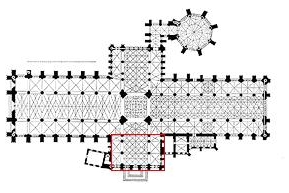 |
Walter de Grey
|
 |
Walter de Grey
|
It's fitting that one of the first memorials encountered when entering the Minster is that to the man whose vision started it all: Walter de Grey. One of the most influential men of his day, Grey had a distinguished career as both politician and churchman (is that redundant?) In 1205, he became chancellor of England under the hapless King John who a few years later signed the Magna Carta with Grey at his side. Three days after signing the Magna Carta, John made Grey Archbishop of York in 1215; but the local church hierarchy rebelled until Pope Innocent III stepped in and made it so. (Recall that a Minster often had monastic roots and the members were used to calling some of the shots).
Despite this inauspicious start, during his forty years as York's archbishop, Grey was instrumental in restoring order to the area, building churches, and getting provincial constitutions in place. Often cathedrals were run by a group of independent secular clerics called Canons while the archbishop would be off on business for the king. In fact, de Grey was left as England's guardian while Henry III was away in France in 1242. (Did he stay at an undisclosed location?)
At that time, York was the junior archdiocese to the more influential Canterbury. In an attempt to gain the upper hand, Grey got caught up in an edifice complex to build the country's largest Cathedral. As was typical for cathedral replacement, the old Norman Minster stood in place while a section was built in the new French style starting with the transepts (first the south, then the north) in 1220. Then a section of the Norman cathedral would be torn down and the next phase started. After 250 years the Norman would disappear and the Gothic masterpiece would emerge. Grey succeeded physically but not religiously: Today York has the larger cathedral but Canterbury's archbishop leads the Anglicans of the world.
Below are pictures taken of another bishop's tomb in the South Transept. Unfortunately, I missed getting a picture of Grey's tomb but the Minster's web sites provides one you can see by clicking here. (The highly elaborate tomb depicted below in the South Transept should be Grey's tomb) Somehow Grey's tomb survived the onslaught of the Reformation, especially during the Elizabethan years when many of the altars and furnishings of the cathedral were removed, defaced, or destroyed. Fortunately, the real iconoclasts, Cromwell's soldiers of the English civil war, were restrained by the commander of the parliamentary forces for the North, Thomas Fairfax, a Yorkshire native (also known as the third lord Fairfax of Cameron for those looking for oil field ties).

While its incumbent is unidentified (to me), his tomb sandwiches his (and his dog's!) effigy beneath the limestone gothic model canopy above and the attentively serious angels below holding shields filled with obscure symbols.

While Grey left behind this magnificent cathedral, he also purchased a home in London which became Whitehall palace, in its day the largest palace complex in Europe and residence of the kings for nearly two centuries. Need more trivia? Today the name Whitehall is used to refer to the UK government.
Besides linked
references, other sources include: "Gray, Walter de." Encyclopędia
Britannica. 2006 and Louise Hampson, York Minster, Jarrold Publishing,
Whitefriars, Norwich NR3 1JR, 2005